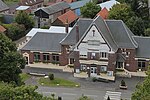The Capture of Eaucourt l'Abbaye (1–3 October 1916) was a tactical incident during the Battle of the Somme. Eaucourt is about 16 mi (26 km) south of Arras, at the junction of the D 929 and the D 10E roads. Eaucourt l'Abbaye (Eaucourt) is north-west of Martinpuich, south-east of Le Sars, south of the Butte de Warlencourt west of Gueudecourt and north-west of Flers. Eaucourt was a group of farm buildings in an enclosure built on the site of an Augustinian abbey, on a side road from Le Sars off the main Albert–Bapaume highway. Destremont Farm to the south-west of Le Sars and a derelict quarry south of Eaucourt had been fortified by the Germans.
Military operations began in the area in September 1914 during the Race to the Sea, when the divisions of the II Bavarian Corps advanced westwards on the north bank of the Somme, towards Albert and Amiens. Eaucourt l'Abbaye became a backwater until 1916, when the British and French began the Battle of the Somme (1 July – 13 November). During the Battle of Flers–Courcelette (15–22 September), divisions of the British III Corps in the Fourth Army advanced close to Eaucourt and operations to capture it began on 1 October. A regiment of the 6th Bavarian Reserve Division in Eaucourt was overrun by a brigade of the 47th (1/2nd London) Division on 1 October, during the Battle of Le Transloy (1 October – 5 November)
Operations continued until 3 October. After Eaucourt was captured, British attacks continued in the area, to take the Butte de Warlencourt, which was captured several times and lost to German counter-attacks, during the rest of the Battle of Le Transloy. In the winter of 1916–1917, which was the worst for fifty years, the area was considered by the troops of the I Anzac Corps to be the foulest sector of the Somme front. Eaucourt was lost on 24 March 1918 during the retreat of the 2nd Division and recaptured for the last time on 26 August, by the 21st Division.










